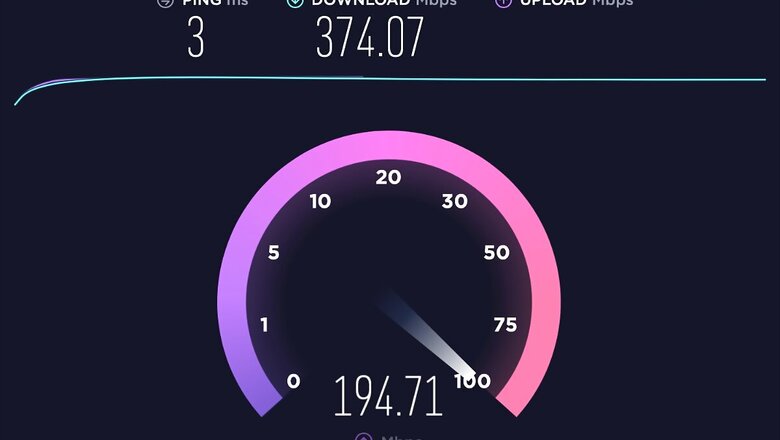
views
It was supposed to happen many years ago, but never did. Home broadband, it seems, was always on the cusp of major adoption. The promise was there. The potential seemed there. Reliable connectivity. Remote working. Online classes. Virtual meetings with your doctor. Smart gadgets and a full connected ecosystem at your home. Voice commands and smart speakers galore. Increased consumption of OTT services, including the likes of Netflix, Amazon Prime Video and Disney+ Hotstar. It all held a lot of promise. We were shown grand visions of a connected life. Yet, it never really clicked into place. Till COVID, or the Coronavirus came along in 2020. As companies including the ones who usually frowned upon anything else except seeing you glued to the workstations in office, suddenly rushed to send everyone home, work from home (WFH) became the new buzz phrase. The condition was, you needed to be connected all the time. How is that possible? With a stable, reliable and fast enough internet line.
But this posed a problem for many. Home broadband was neglected in most homes all along. Cost was the primary reason. Seen as an expense that could be avoided. Mind you, most households avoided spending Rs 1000 per month or so for a wired broadband line, for as long as they could. We have 4G hotspots and 4G on our phones, many said. It works, they said. While they were making do with their 3G and 4G connections for streaming Netflix and sending the occasional emails all this while in the evenings or on weekends, it just wouldn’t cut it when all your neighbours are also hooked up to the same mobile tower trying to get work done almost 9 to 10 hours a day. Dropped video calls, the annoyances of “email attachments aren’t uploading” and “I have no network at home” doesn’t work when serious office work has to be replicated at home. Chances are, you are among the growing number of home broadband users in India who are now relying on fast and reliable internet to get work done, have their child attend online classes, maybe even a quick spot of online gym in the morning and maybe once the madness of the day is over, some online gaming or binge watching to usher in the night. The Telecom Regulatory Authority of India (TRAI) data suggests India has clocked 21.51 million wired broadband subscribers as of the end of October 2020, a steady growth through the year.
One thing is very clear—a 4G mobile data connection may have worked well for you over the past few years. Netflix, web browsing, music streaming and instant messaging, all worked. But now it can’t. Mobile data speeds, particularly with the unique situation that we are in which sees extensive load on mobile networks in residential areas, will never mostly be unable to let you do a Zoom video meeting and simultaneously allow your child to attend an online class as well. Wired broadband has the potential for much faster speeds, wider bandwidth, lower ping rates and a much faster browsing and streaming experience overall. Interesting then, that this change comes as we celebrate the 25 years of internet in India, a milestone that perhaps is most significant in these times.
But what were the troubles all this while? The sluggish growth of wired broadband over the past few years can be blamed on multiple issues. Regulatory hurdles, lack of fiber infrastructure and the cost of services combined to keep services reigned in, to put it mildly, and kept consumers away. Often, the biggest players in the wired broadband space are also popular telecom companies. Airtel and Vodafone, for instance. The latter runs the You Broadband service. With the long drawn sagas over the 2G spectrum and 3G spectrum allocations and the costs associated with it for telcos at different points in the past decade and a bit more, it was perhaps to be expected that their investment capacity in the home broadband services would be limited. Which is why, for instance, for the longest time Airtel Broadband retained the DSL backbone for its home broadband services. The company did invest in upgrading ADSL lines to VDSL, which used a vectoring technology to offer better speeds. Yet, the challenges of the very basic technology meant distance covered, quality of cables and reliability of service was never really as good as expected. And speeds were limited too.
The reality, till at least mid-2018 was that market leaders such as Airtel weren’t pushing wired broadband services aggressively. The competition, which included the likes of Spectranet (now called Spectra), ACT Broadband, Hathway at the time, DEN broadband and others never really got around to actually competing. Perhaps the way we are seeing it happen now. A lot changed in 2018 when Reliance officially launched the JioFiber broadband service. We often credit Jio for changing the very landscape of mobility services in India with affordable prices and quality of 4G network coverage. The data suggests since JioFiber made its way into the home broadband market, rivals have had to really get their act together. The numbers prove it.
If we are to look at the Netflix ISP Speed Index data starting September 2018 when JioFiber officially rolled out, it retained the number one rank all the way till the end of April 2019 offering the fastest average speed on the network compared with all rivals. In fact, in September 2018, Reliance JioFiber logged into the rankings with prime time Netflix performance of 3.41Mbps. In comparison, Airtel broadband was still logging in at 2.98Mbps and Spectra clocked 3.07Mbps. Fast forward to January 2020, the last Netflix ISP Speed Index data logged before the pandemic, and we have proof of what competition does. Reliance JioFiber leads the way with 3.63Mbps speeds, while Spectra logs in with 3.5Mbps and Airtel broadband, now Airtel Xstream fiber for many lucky users around the country as the fiber upgrade is happening rapidly, clocks in with 3.48Mbps. These numbers may not look a lot, but a consistent uptake of higher speed broadband plans at affordable prices across the network coupled with consistent delivery of the speed and services, has a huge bearing on this data. It is great news for customers, who now get more bang for their broadband buck.
“India’s fixed broadband market remains highly underdeveloped due to the dominance of the mobile platform and in turn by the uptake of mobile broadband. Fixed broadband penetration is expected to grow at a moderate rate over the next five years to 2024 from this very small base,” the “India – Telecoms, Mobile and Broadband – Statistics and Analyses” report by ResearchAndMarkets.com had said in September last year. The government is intent on doing its bit to push wired broadband and indeed 5G, which plug into the larger Digital India initiative. One such move is the plan to roll out public Wi-Fi across the country, for uninterrupted connectivity.
This puts even greater emphasis on 5G. The Indian government, with its Make in India campaign is pushing to make India a global manufacturing hub. “5G in India is expected to provide the network to keep these factories connected real time with suppliers and customers, thereby making them smarter and much more efficient – the factories of the future,” says Deloitte in its “5G: The Catalyst to Digital Revolution in India” report. Remote medicine, virtual banking, more 4K and 8K content streaming subscriptions, Augmented Reality (AR), IoT, Big data analytics and Artificial Intelligence will all get a boost because of faster internet around us. Be it at home, or be it while we are on the move. Wired or wireless. India is trailing behind most developed countries in the race for 5G networks. According to network testing provider VIAVI, as of January this year, 5G networks were available in 378 cities across 34 countries. As of that time, South Korea led the way with coverage in 85 cities, China followed with 5G networks in 57 cities, US with 50 5G ready cities and UK already has more than 31 cities with 5G mobile networks. India has some serious catching up to do.
Whichever way you look at it, one thing is clear—we are heading into a bright era where fast and reliable internet will potentially be the norm. Competition will force better quality of services across the board. Lots of value adds, such as Amazon Prime and Netflix subscriptions bundled too. At subscription prices that don’t hurt the wallet. Including for world class connections at 1Gbps speeds. This change is a part of the new definition of work from home, and is undoubtedly the very foundation of why you are able to work remotely. Maybe we need to love that humble internet wire that is snaking into our homes.
Read all the Latest News, Breaking News and Coronavirus News here


















Comments
0 comment